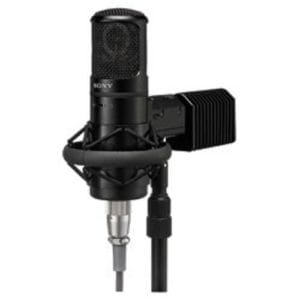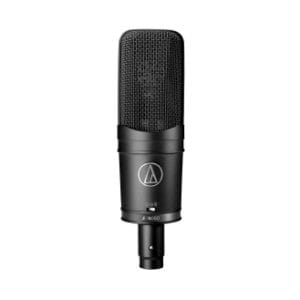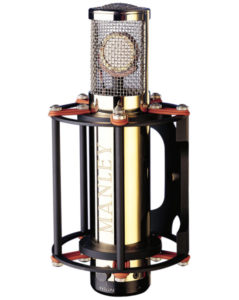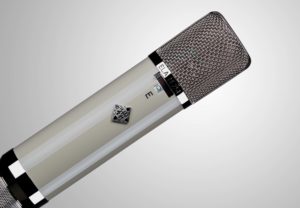Choosing the right vocal microphone for your studio recordings is a major up-front factor in the quality of your end-result. Barring the pop filter, your microphone is the first thing your voice “touches” in a chain of gear, signal paths and processing. Determining what is “best” for you requires time spent on the microphone. It also takes self-awareness combined with a producer/engineer who hears what works best for your voice and the music around it.
Contents
The Concept of “Best”
There are important questions to ask yourself when you start researching which microphone(s) you want to purchase.
Here are a of those “concepts of best” to consider before we go into more details.
Which microphones are:
- Best for your voice? For example are you more of a vocal singer or are you recording rap music?
- Best for your application/purpose?
- Best for general use?
- Best within your budget?
- Best as seen by industry pros?
- Best as seen by artists/consumers?
- The best-selling and why?
Which microphones have the:
- Best amount of positive reviews?
- Best specs and features?
- Best intangible or “magic” factors?
The Specifics of “Best”
All best-of items have certain things that make them the best at what they do. These are the tehcnical specifics that the best studio microphone brands focus on to vault their products to the top:
- Large or Small Diaphragm
- Signal to Noise Ratio
- Frequency Response
- Response Curves
- Capsule
- Transformer
- Polar Patterns or Multi Patterns
- Proximity Effect
- Sound Pressure Level (SPL) and Sensitivity
Large or Small Diaphragm
Both have their benefits, but large diaphragm microphones are the ones most-often used for recording vocals. Their noise performance level is the main advantage they boast, and they allow for capturing audio that simply sounds like it should be on a record.
Small diaphragm microphones are paradoxically more detailed while also being less colored. If you want something to sound the way it sounds with no coloring or shaping influence, use a small diaphragm condenser mic.
Signal to Noise Ratio
The signal to noise ratio is the amount of direct sound you get from the performance source into the microphone as opposed to the excess, reflective and transient sounds you get around it and in the background of your recording.
If you hear a demo recording with a fuzzy vocal or lots of hiss, chances are the microphone used had a bad signal to noise ratio.
When you hear those vocals on the radio or in your favorite recordings that sound like velvet and are isolated into almost cartoonishly-good locations in the mix, the microphone that recorded them had a great signal to noise ratio.
You can achieve a great SNR by how close you place the microphone to the sound source and by eliminating reflections and background noise around the recording area with soundproofing and isolation. This is hard to do in home recordings, but can be achieved with a microphone suited to your needs that also focuses its technical efforts on the best SNR possible.
Frequency Response
Just like human ears can only hear frequencies within a certain range, microphones can only capture them within certain ranges. Some engineers cut from 250hz down on vocals in their mixes. Some cut from 100hz down and others cut based on specific needs. Different microphones dial in different ranges. If you’re buying a mic for a variety of purposes, get one with a broader frequency response range such as 20Hz to 20kHz. If you’re using it specifically -or only – for vocals, you can go with the 80Hz-15kHz range.
Response Curves
Just because a microphone can respond to a broad range of frequencies doesn’t mean it repsonds the same way in all areas. This might be one of the most important factors to consider when purchasing a mic for your own vocals. Some mics sound better at 2k or 5k and some have a bump in the low, mid-range. Some may be round on the bottom and light on the top. Knowing your own voice, or the voice of the person you’re recording, is a big help in determining which mic’s response curve is best for you.
Capsule
The capsule is the main source of converting analog sound (your vocal) to digital audio (the recording). Air pressure against the capsule pushes it against a backplate at different velocities that affect the voltage that is responsible for the A/D conversion. The capsule is the internal filter through which your vocal is transformed into a recording. Therfore, a good capsule is essential. For more details on types of microphone capsules and what they do, please check out Recording Hacks and TapeOp for comprehensive information
Transformer
Transformers are used to match or balance out differentials between microphones and the gear they’re running through or connected to. Ribbon mics have low voltage and impedance and transformers help them reach normal output levels. Tube mics use high impedance circuits that need to be matched to normal outputs. And microphones also need to be matched to preamp circuits. A high-quality transformer can help improve signal to noise ratio and also better isolate and balance your signal.
Polar Patterns or Multi Patterns
A polar pattern is essentially the way in which a microphone receives sound. It affects the direction from which the sound is processed and the shape of that sounds as it hits the capsule. Bi-directional mics (Figure 8) pick up from two opposite sides (such as front and back) while ignoring input from the left and right sides. Unidirectional mics can be:
- Cardioid
- Supercardioid
- Hypercardioid
Take a look at this succinct and informative description of these mic patterns from The Hub at Musician’s Friend:
There are also Multi-Pattern microphones out there that let you switch from pattern to pattern and therefore give you more versatility when recording.
Proximity Effect
This is a “spec” made for recording artists who really know how to use a microphone. It is also known as a “sweet spot.” Certain mics have magic at certain distances from the signal (your voice). Stage mics like the SM58 are designed to be swallowed. Studio microphones react differently based on signal placement, and to get the best recordings you need to know how to use that to your advantage.
Sound Pressure Level (SPL) and Sensitivity
The SPL is the maximum amount of volume (decibels) a microphone can handle. Ribbon mics are more sensitive and can handle less volume before blowing up, etc. A studio microphone’s sensitivity determines how quiet a signal it can pick up. The lower the number in the rating, the more that mic can “hear.”
All of these things are important and specific elements in what goes into making a studio microphone the best for recording your vocals.
What Are You Looking – and Listening – For?
Imagine telling Eric Clapton to use a Tele instead of a Strat. Try telling Keith Richards to put down ol’ Butterscotch and play a Flying V instead.
What is it you are looking – and listening for – in a studio, vocal microphone?
- Your vocal sound.
- Your project/music style.
- Are you a home-based or professional-based vocalist, or both?
- Your budget.
- Versatility vs. Specific Sonic Qualities
- Is this your personal microphone for your vocals only or will it be added to a collection in you studio, microphone closet?
- Audio reviews and comparison test results.
Red Flags & Warning Signs
Be careful when buying used microphones. There is no “blue book” out there to guide you. If a microphone has been dropped, it may have tested well pre-sale but that one loose wire or imminent hairline fracture in the capsule could quickly turn into a short or unusable product. If your favorite mic is out of production and you find a used one for sale on eBay, amazon.com or Craigslist, be sure to ask a lot of questions and be confident in your decision before buying.
Keep an eye on companies claiming that their $50 microphone compares to “anything good”. Also, when you’re buying online, make sure the seller (whether an individual or a store/business) took the time to post detailed specs and multiple pictures – not just a stock photo and a “works great” type of comment. A company’s availability and willingness to talk to its customers pre-purchase is a good sign that you can trust the quality of what you’re buying.
Top 8 Recording Microphones for vocals/singers in 2018:
Sony C-800g
Best Overall Studio Vocal Microphone
The Sony C-800g is the best overall recording microphone. If you can own one, then own one. It’s on countless hit records and it considered the absolute best by man industry gurus. It’s one of those mics, though, that can make a bad singer sound worse. There is no hiding behind this microphone. So while I agree this mic can capture magic like almost no other, the magic really needsto be there to be captured in the first place.
Here’s a great comparison test between the C-800g and the Slate VMS (Virtual Mic System).
The Sony beats the Slate in the verse sections to my ears. It’s more “alive” and “magical.” But when it gets to the chorus section, I prefer the sound of the slate for the falsetto, high vocals in this demonstration. I like to record to tape the way I want it to be in the mix as best as possible, and the Slate dials in this singer’s vocals the way I would want them to be tracked.Sony C-800g
Here is a female vocalist comparing the Sony C-800g with a Peluso VTB Microphone. In this demonstration they actually don’t tell you which is which when A/B-ing mics. You have to make your own, un-influenced decision with your ears alone. It’s kind of refreshing and aggravating at the same time.
This is my final Sony vs. the world video selection. It’s another Slate vs. Sony battle, with processed and un-processed audio. In this demonstration, I think you can clearly hear how the virtue of the Sony C-800g is that, when processed, it just has an “x-factor” that stands out in mixes.
All Sony-championing aside, there are other mircrophones that can also capture magic and have their own x-factors.
Audio Technica AT4050
Best Value Studio Microphone
There is a big, wide, on-stage sound to these mics. I think the 4050 is broader and grittier than its more expensive counterpart. The 5040 is definitely more dialed in when in-the-mix. I just think from the 2020 on up Audio Technica has good products. Granted, they are not going to sit in the same way as any other mics on this list so far. Their width scares off some people. But you can be off the 4050 a bit when singing and really bring the room into your recording. You can also pair 2 of them up ad use them for room mics, no doubt. They’re rugged and can handle a lot of versatility. I would always have a pair of 4050’s in my closet if and when I could.
AKG 414XLS
Best Rock/Versatile Vocal Studio Microphone
AKG has a great, user-friendly system that lets you flip back and forth between a large variety of sounds going through its many microphones. Take a listen here and make your own choice. The 414XLS stands out to me in the “air” department. I also liked it on piano and horns, to be fair. It may not have the magic of the top 2 mics on this list, but it is definitely a high-end workhorse of a product. I particularly liked the female high vocal and male mid vocal through the 414XLS. If it sounds “boxy” as Shaffer put it, I didn’t hear that. The fact that I liked it on instruments (including acoustic guitar) outside vocals make this my choice for a reasonably-priced, versatile microphone.
Studio Projects C1
Best Background Vocal Studio Microphone
Yep. This is where the Studio Projects C1 slides in. I said it before – I like it when a microphone records background vocals up front the way I want them to be carved or sitting in the end. The C1 does that for my tastes and needs. It’s got a lot of air, and may not be everyone’s cup of tea. I don’t know that my voice would be a good match for it. But that doesn’t mean it’s not a great mic at a great price. It’s also versatile, and you can check out some specs and descriptions here.
As always, the best guage of a microphones quality and usefullness is in how it sounds and translates in a mix. I know for a fact that the Studio Projects C1 was the main vocal mic used on Along The Way by Corianne Silvers. You can hear the velvet, shimmer and brightness of the C1 across the board on all her tunes. Again, you might not dig it, and I wouldn’t record my voice with it. But I also have background vocal tracks recorded by Corianne on one of my songs, and the C1 is perfect for that application.
Manley Reference Gold
Second Option Studio Vocal Microphone for Vocals
This is a smooth-sounding microphone. It soaks in the sound, to my ears. It’s expensive – more expensive than the Z-251’s but not as pricey as the Sony. You can find it on Amazon.com for less thatn $5,000.
Here are some well researched microphone comparisons between the Sony c800g and the Manly Cardiod Reference:
ADK Z-251
Second Best Overall
I don’t have any cons for this mic, I really don’t. It’s alive. For my voice, it cuts, but it settles right in there. It captures, but sets sound free. If I was forced to pretend there was a drawback to it I’d reluctantly say that my voice was so present while recording I had to be extra aware of how I used the mic. But that’s not a drawback – it’s a blessing. For my voice and tastes I’d take this mic over the Sony. At the very least I have to say the fight goes into the last round and is a judge’s decision, not a knockout.
Jenson Vs. Sowter Transformer Shootout
ADK bases their mic models on “color” of sound. Villella knows that application of a microphone is essential to its success. So does a band called “The Running Mates.” The use ADK mics (apparently an endorsement deal, but who cares) and you can hear their audio examples here.
The transformer thing is big with ADK. You can swap them out and really build a mic that is customized for your sound and needs. I agree with the assessment above that I like the Sowter better than the Jenson. Villella suggested that to me as well.
Coles 4038 Ribbon
Best Ribbon Mic For Vocals
The cons are you have to watch how hard you hit it when singing. The pros are everything else, as far as I’m concerned. These mics lost popularity at some point but resurged into being one of the most highly regarded ribbon mics in use. Matched, stereo pairs make for great brass and string recordings, true. But used properly this mic can sit a fat vocal down in your lap and melt you with its warmth. Check out these mixes using the Coles 4038 on the lead vocals:
Sixpence None The Richer – Kiss Me
I want to kiss the mic. And honestly, the Siren Song vocal has a darker tone to it. But Kiss Me does not. Ribbons are good. The Coles 4038 are my favorites for vocals.
For other fans, here is a bit of history on the Coles 4038.
Final Thoughts
All the microphones in the article have something to offer someone. The most important thing above all others is to match the microphone with your vocal sound and needs. There are budget companies out there pretending to be big players. There are expensive microphones out there that aren’t $5-10k better than cheaper options. There are midland companies that have stunningly – and surprisingly – good products.
The best studio microphones for recording vocals combine great tech with great color and inspiration. What makes one microhpone the best over others depends on your voice, and, how you use them all.








